This poster by Drew Struzan turned up in my RSS feed courtesy of 70s Sci-Fi Art. So Struzan did the US poster for Squirm, thought I, …who knew? Wait a minute…are those Klimt figures?! Closer scrutiny confirmed that, yes, Struzan does indeed appear to have swiped a handful of figures from Gustav Klimt as victims for the carnivorous worms. Squirm (1976) for those who haven’t seen it, is described by The Psychotronic Encyclopedia of Film as:
Pretty bad film about electrified earthworms in Georgia that have teeth and make noises like horses. It does have an amazing scene with long worms burrowing through a man’s face. Whole rooms are filled with what looks like thick spaghetti. Don Scardino is the studious young hero. The ads claimed there were “250,000 real worms” in the film. From the director of Blue Sunshine.
Michael Weldon’s book has a very lenient attitude towards this kind of nonsense so for a film to be labelled as bad is always a warning. Having seen Squirm, I agree with Weldon’s appraisal. There were a lot of animals attacking humans in the cinema of the 1970s, thanks in part to the success of Jaws, so a story about worms on the rampage is merely another addition to the trashy pile. (The Japanese poster even managed to emulate the famous Jaws poster.) Squirm is especially ridiculous when the humble earthworm is so resistant to being any kind of menace unless its size is dramatically increased, as in Dune or Tremors, the latter being a much better horror film with its own Jaws-like poster.
Jurisprudence (1907) by Gustav Klimt.
Struzan’s figures are based on those in Jurisprudence, one of the paintings that Gustav Klimt worked on from 1900 to 1907 for the ceiling of the Great Hall at the University of Vienna. There were three pictures—the others represented Philosophy and Medicine—but all were deemed too pornographic for public display. The paintings were subsequently destroyed in 1945 by retreating Nazi troops after having been seized from their Jewish owners and moved with other loot to the Schloss Immendorf.
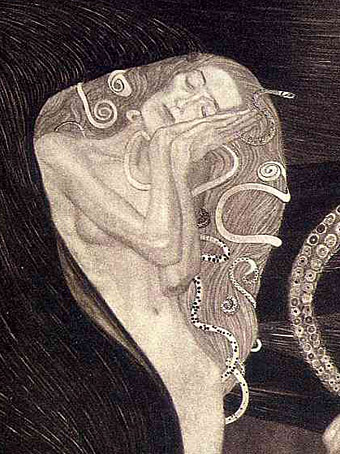
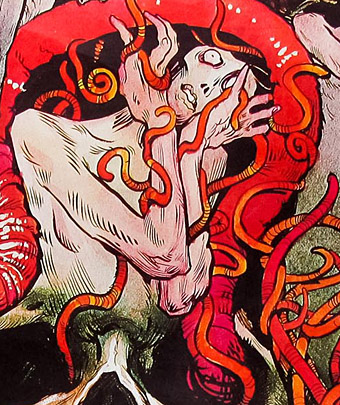
Klimt’s Jurisprudence is the strangest of all his works, with three Furies presiding over the cowed figure of a man ensnared by evil, represented here by an octopus. Philippe Jullian in Dreamers of Decadence declares Klimt’s symbolic cephalopod to be “unique in European Art”. I alluded to the Furies, and thereby surreptitiously alluded to those tentacles of evil, when I put a Klimt-like figure into my adaptation The Call of Cthulhu in 1988.
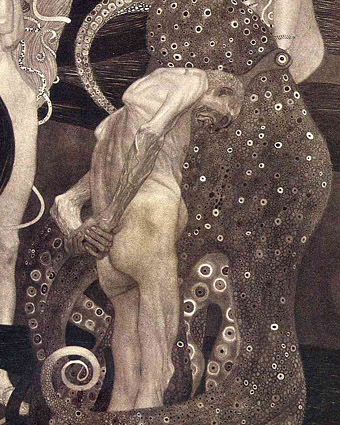
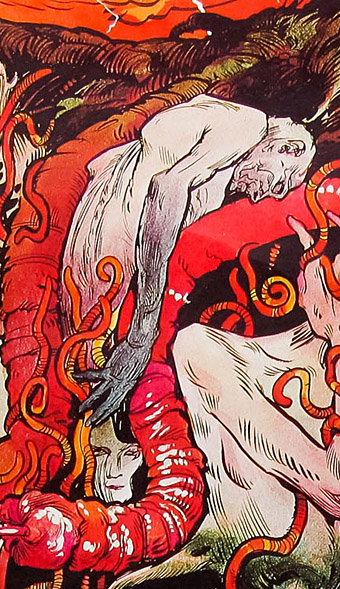
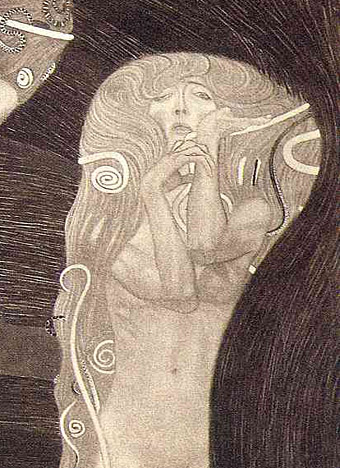
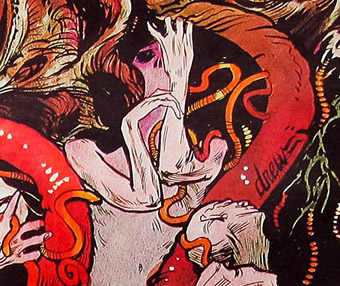
Another of Struzan’s figures (below) is taken from Klimt’s Procession of the Dead (1903), the original of which perished in the same fire that destroyed Jurisprudence, while some of Struzan’s faces may be derived from those in the Gorgon section of Klimt’s Beethoven Frieze. The figure on the far left of Struzan’s poster also seems familiar, and may be based on an Egon Schiele painting although I’ve been unable to find a matching picture. Schiele or no, that’s a lot of art history for a worm film.
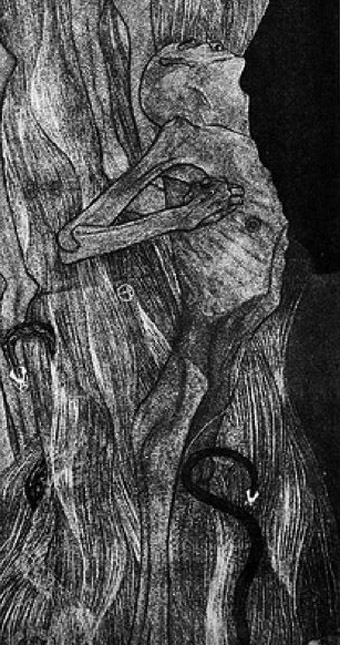
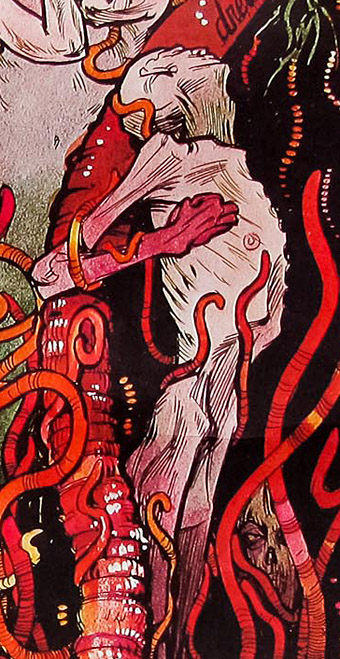
The intersection of AIP’s wormsploitation with the Viennese Secession is so unlikely that I have to wonder why the very accomplished Struzan did this when he isn’t the kind of artist who needs to borrow figures. I’d guess it was a way of making a dull commission more personally interesting. And maybe a challenge to the viewer…how many people have ever noticed this connection? This wasn’t the first time that an AIP poster had been classed-up by borrowing from a superior source, but Reynold Brown’s poster for Roger Corman’s House of Usher takes its coffin from a Harry Clarke drawing for another Poe story, The Premature Burial. Struzan’s poster isn’t the only one that borrows from Klimt, I can think of at least one more, Bob Peak’s splendid creation for Paul Schrader’s The Comfort of Strangers. I still haven’t seen Schrader’s film but I doubt it features anyone being eaten alive by worms that sound like horses. For the Squirm-curious, there’s a trailer here.
Previously on { feuilleton }
• New Life for the Decadents by Philippe Jullian
• Intertextuality
• Symbolist cinema

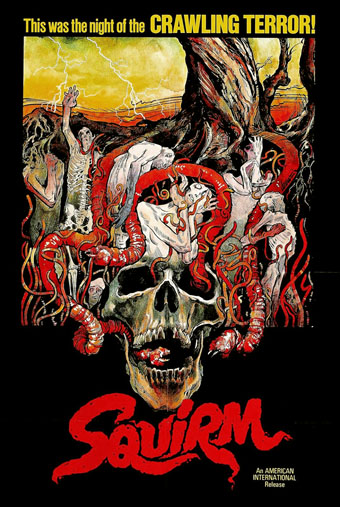
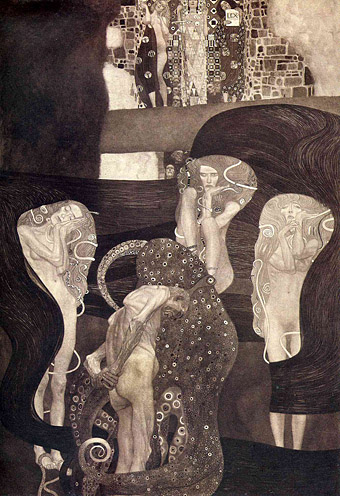
Can’t really let a Squirm-related post go by without mentioning the cover to the 1978 Sphere (naturally) paperback, which can be seen here: https://www.steve-calvert.co.uk/book-review-squirm-richard-curtis/. I don’t *think* it’s the Four Weddings Richard Curtis, but I haven’t researched this, so who knows?
Anyway, it found its way into our house as part of one of my dad’s bulk paperback swaps, and became an instant childhood favourite to be smuggled into school and shown around.
I expect if you’d bought this from WH Smith, cut the cover off, stuck a stamp on the back and posted it to someone, you might well have ended up in the dock.
Thanks, I definitely remember that cover. According to ISFDB it’s another Richard Curtis, an American who also wrote How to Prosper in the Coming Apocalypse (1981), and How to Get Your e-Book Published (2002). He ought to try combining the two: How to Get Your e-Book Published in the Coming Apocalypse